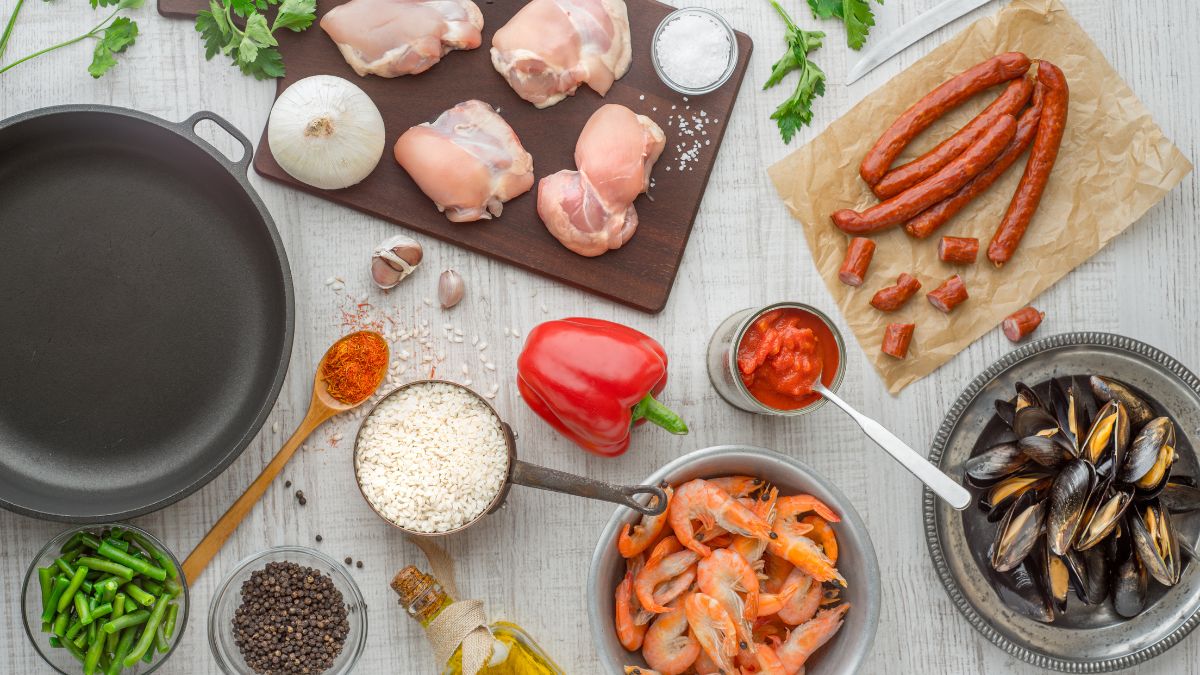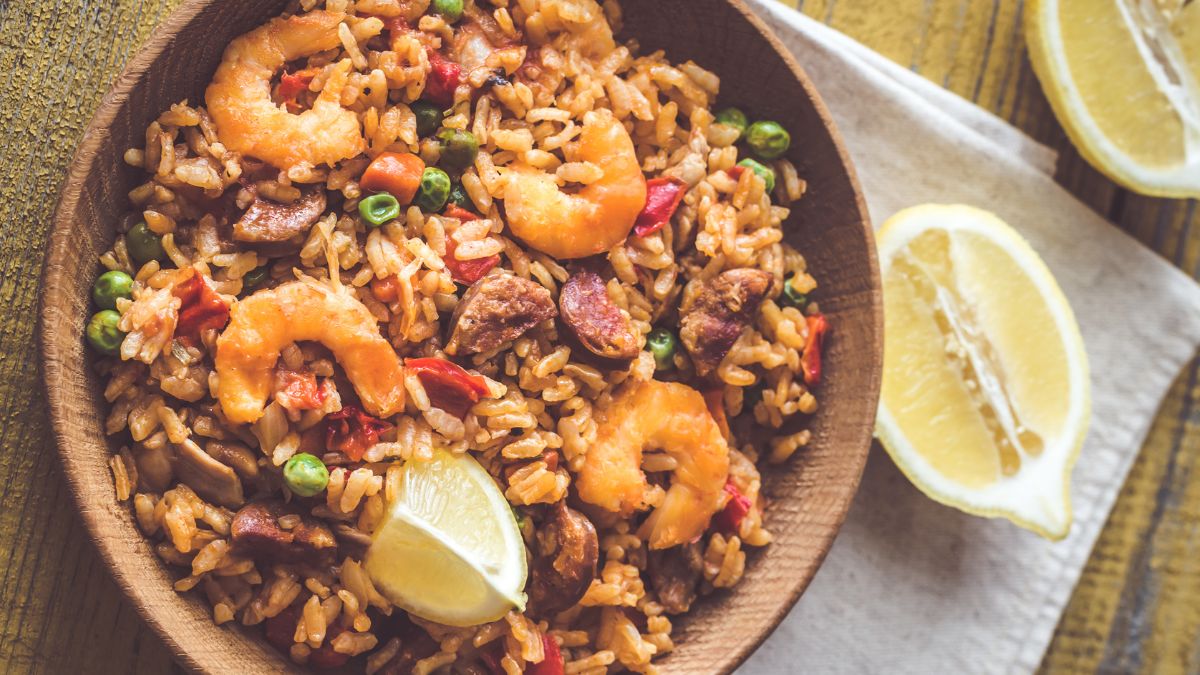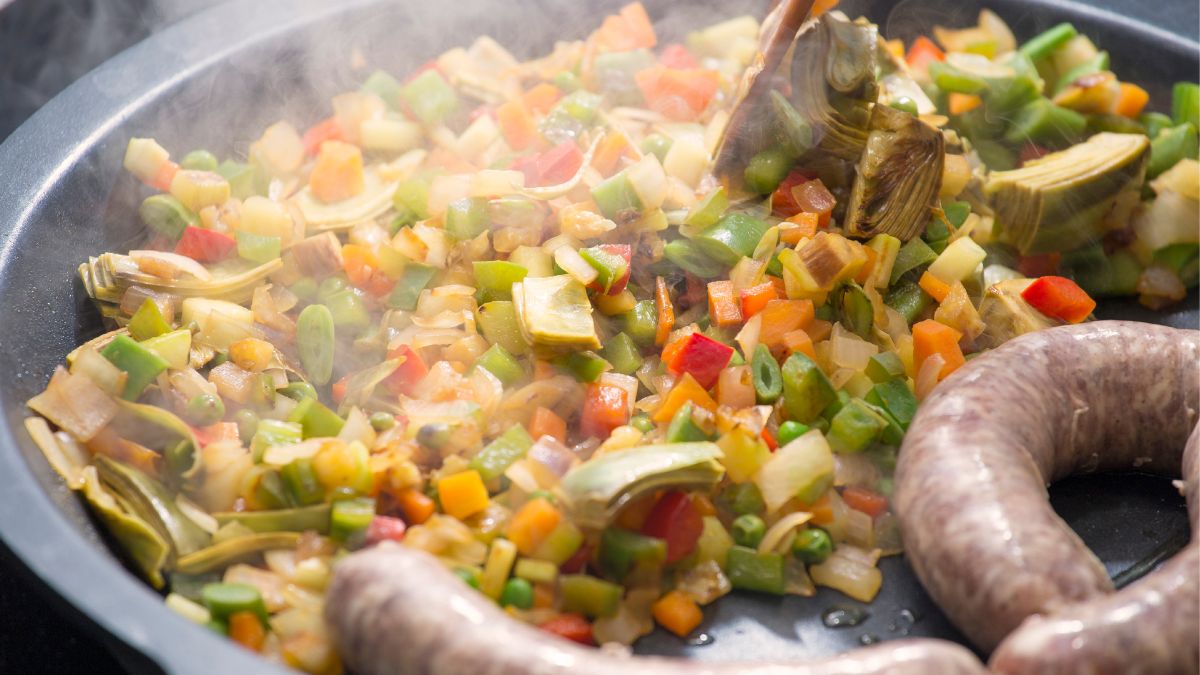What Are 5 Main Ingredients in Paella?

As someone who loves to cook and eat, discovering authentic recipes from different cultures is a passion of mine. When I think of Spanish cuisine, paella is the first thing that pops into my mind. The vibrant saffron-infused rice dish originating from Valencia is a flavor explosion. But what makes it authentic? After trying many recipes, I’ve found the key is using high-quality ingredients that provide fantastic depth of flavor. But what are the 5 main ingredients in paella?
Saffron, olive oil, rice, and broth provide the base for paella. Then come meat, seafood, veggies, or a combination of all three, depending on your tastes and what’s fresh at the market. The blend of spices and herbs ties all the ingredients together, giving paella a distinctive flavor.
Using the right ingredients is essential for an authentic paella experience that will transport you to the Mediterranean coast of Spain with each delicious bite. Don’t forget that using high-quality ingredients is vital to achieving maximum flavor in this dish. So, let’s dive into the details!
Saffron
For me, saffron is what makes paella paella. Saffron is the crucial ingredient that gives paella its signature yellow color and distinctive flavor. As a home cook, I always use the highest quality saffron I can afford — it makes a massive difference.
Saffron comes from the dried stigmas of the saffron crocus flower, and it takes over 70,000 flowers to produce just one pound of saffron threads. Because of the labor-intensive harvest, saffron is the world’s most expensive spice. But a little goes a long way — usually, you’ll need just a pinch or two for an entire paella.
You should crush the saffron threads to release their flavor before adding them to the rice. I like to steep the threads in a bit of hot water or broth for at least 30 minutes. The liquid takes on an intense yellow-orange color and a slightly bitter, hay-like flavor with subtle floral notes. This saffron infusion is then added to the rice, along with veggies and broth.
The flavor of saffron is an essential part of what makes paella unique. As the paella cooks, the saffron slowly permeates the rice, giving it a yellow tint and distinctive, unmistakably Spanish taste. While expensive, just a tiny amount of high-quality saffron can transform a simple rice dish into an authentic Spanish classic.
Still, finding pure saffron may be a bit harder than expected. So, learn how to test its quality!
Rice
When making authentic Spanish paella, the type of rice you use is critical. In my opinion, short-grain bomba rice is the best choice.
Bomba rice is a short-grain rice that can absorb flavorful liquid while remaining firm and separate. It has a high starch content, so it gets nice and sticky when cooked, which helps give paella its characteristic creamy texture.
This type of rice is considered the premium rice for paella in Spain. It’s able to soak up saffron and seafood flavors particularly well. Other types of rice, like long-grain white rice or jasmine rice, won’t produce the same results. They tend to get mushy when cooked in paella and absorb less flavor.
Bomba rice may cost a bit more, but for an authentic Spanish paella experience, it’s worth the investment. The specific type of rice used is vital to achieving the right texture, taste, and appearance. When you see pictures of delicious, vibrant yellow paella, it’s very likely made with bomba rice.
If you don’t have any bomba rice at hand, you can always compromise and use the most similar type of rice available or simply cook up a dish that’s similar to paella. Either way, you can’t go wrong — just look at all the alternatives!
Stock
For the most authentic taste of Spain in every bite, homemade stock is essential. No paella is complete without it! Simmer the shells and trimmings of shrimp, crab, and white fish like cod or hake in water with onions, garlic, parsley, and bay leaves. Strain and use in your paella. The longer you simmer, the more intense the seafood flavor will be.
Seafood stock provides a salty, savory flavor that enhances the taste of the rice and other ingredients. The stock is also naturally gluten-free, unlike many pre-made stocks, which often contain wheat.
Unlike store-bought versions, homemade stock contains no artificial flavors, colors, or preservatives.
If you prefer a meaty paella, use homemade beef, chicken, or vegetable stock instead of seafood. Beef or chicken stock provides a rich, savory base for rice and meat ingredients like chorizo, chicken, or rabbit. Vegetable stock works for vegetarian paella.
Whichever stock you choose, use it to sauté the onions and garlic, then add it to the rice, saffron, and tomatoes. The stock moistens the rice as it cooks, infusing it with layers of flavor. As the rice absorbs the stock, the flavors intensify.
Protein

When it comes to paella, the protein you choose is key. For me, seafood is always a favorite. Shrimp, mussels, and calamari are classic choices that provide a nice mix of textures.
If you prefer meat, chicken and chorizo sausage are also traditional options. Chorizo, in particular, adds a nice spicy kick and smoky flavor to the rice, but you can also use one of its substitutes. For a heartier meal, you could also add diced pork. Just be sure not to overload the paella with too much meat, or it can become heavy.
For vegetarians or vegans, many vegetable variations of paella are delicious. Artichoke hearts, asparagus, mushrooms, and peppers are all flavorful choices. You can also add beans like chickpeas for protein. A vegetable paella may need extra seasoning to compensate for the lack of seafood or meat, so be generous with saffron, paprika, garlic, and fresh herbs.
Vegetables

Your vegetables are just as important as the rice and saffron. Onions, garlic, and tomatoes provide a flavorful base for the dish.
No Spanish dish is complete without onions and garlic. Sweet onions like Vidalias or Walla Wallas and fresh garlic are the best for paella. Finely dice the onions and mince 3-4 cloves of garlic. Saute them in olive oil until the onions are translucent and the garlic is fragrant. The aromatics will infuse the entire dish with flavor.
Tomatoes add a touch of acidity and natural sweetness. Just drain the excess juice so the paella isn’t too soupy. Simmer the tomatoes with the onions and garlic until slightly reduced.
Colorful bell peppers, especially red and yellow ones, make paella even more vibrant and flavorful. You can also add diced chili peppers for some heat if desired.
Lastly, mushrooms, green beans, peas, or asparagus also work great in paella. Saute mushrooms with the onions and garlic, blanch green beans, peas, or asparagus, then add to the paella during the last few minutes of cooking.
The vegetables provide a balanced mix of flavors and textures in paella. With the blend of spices and saffron, the vegetables are a key part of what makes paella such a delicious one-pot meal.
What do you use when making paella at home? Can’t wait to learn about your experience in the comments below!
